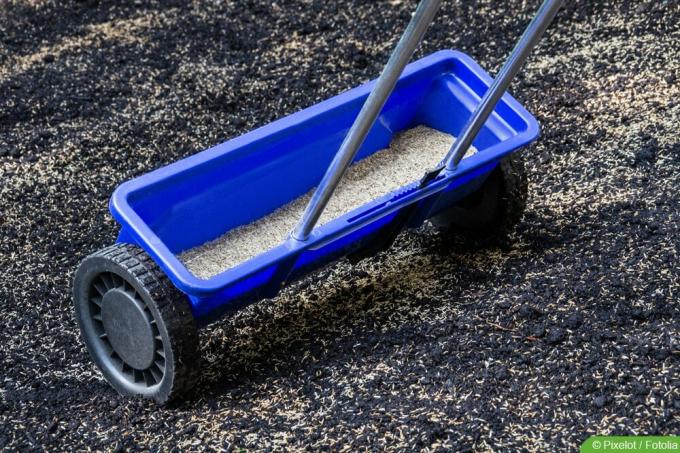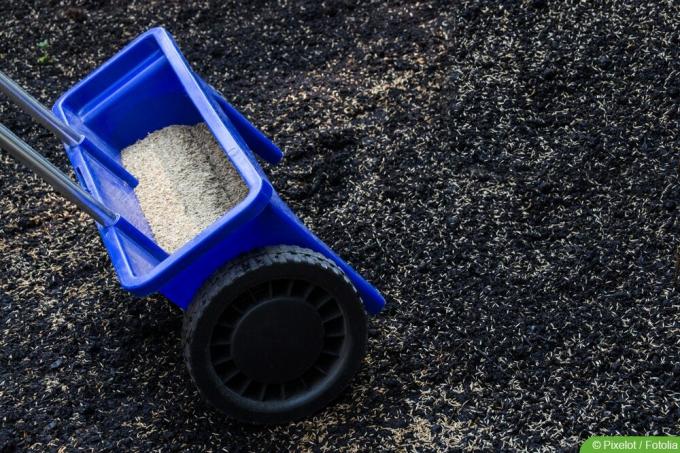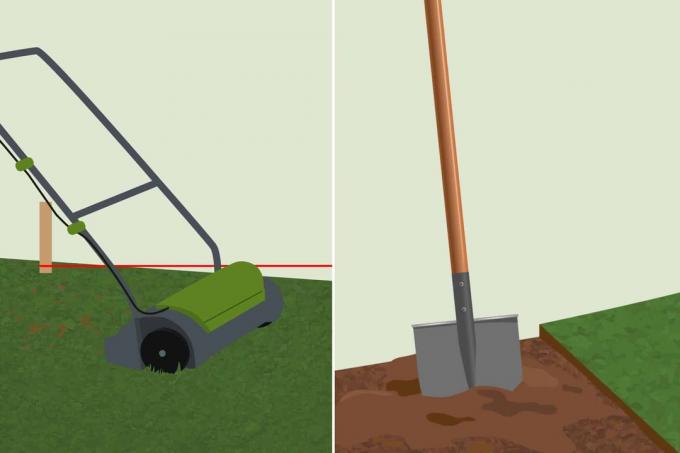

Table of contents
- How a spreader works
- soil preparation
- select seeds
- Prepare seed
- use a spreader
- After sowing
A beautiful and well-groomed lawn stands and falls with the even sowing of grass seed. Professional gardeners often have to practice regular seeding by hand over many years. Many hobby gardeners do not have that long, which is why they can help themselves with spreaders. The wagon not only makes sowing easier, but also helps to distribute the seeds evenly over the area.
How a spreader works
Spreaders can be used in many ways in the garden. They are used to spread fertilizer, seeds or substrates. The wagon usually has a setting that can be used to regulate how much spreading material can be spread. By adjusting the size, spreading material of different sizes can also be spread. The spreading material later falls out of the wagon due to the forward movement. Only forward movement opens the hatches and when reversing they remain closed. This prevents spreading material being spread twice on one area.
Tip:
There are models of spreaders that have color markings, which indicate areas that have already been spread. Such models cost a little more, but are suitable for large areas or areas. useful for frequent use.
Spreaders can be used all year round not only for spreading seeds on lawns. The trolleys offer the following usage options:
- Sow
- Fertilize
- sprinkle salt
- Application of crumbly substances

Although the trolley is often used on paths and lawns, it can also be helpful in the bed. Fertilizer can be applied evenly with the wagon when preparing the beds. Other agents such as plant protection products in the form of granules can also be distributed evenly with the trolley.
soil preparation
Before sowing the seed with a wagon, the soil must be prepared. Lawn soils are often heavily compacted areas that do not form the best basis for seed. The soil should be loose, so compacted soil should be loosened first. Standard garden tillers can be used for this. So that the spreading material can later be spread evenly, the soil must be leveled again after loosening. A large spirit level should definitely be used for this. Although the floor can never be made completely level, larger unevenness can be prevented by measuring. So that the soil remains flat, it is compacted again with a roller.
select seeds
Before the grass seed is spread, a suitable mixture must be selected. From sports turf to English turf, there are different mixtures with grass seeds. The mixtures differ in the composition of the grasses. The grass mixture for English lawns, for example, is not as hard-wearing as grasses for sports fields. The selection of the seed depends on the later use. There are ready-made mixtures on the market, for example for recreational lawns. Lawn mixtures can also be put together individually in specialist shops. In this way, the grass mixture can be adapted to a special use or the soil or climatic conditions are adjusted.
Tip:
A grass mixture for a recreational lawn is usually the most popular choice. It is robust and easy to maintain.
Prepare seed
While no further preparation is required for manual spreading, the grass seed is usually too small for spreaders. The quantity cannot be set so small that too much seed cannot be sown at certain points. The lawn seed must therefore be mixed with another substrate. The seeds can be mixed with different substrates. For example:
- sand
- fine compost
- fertilizer
When mixing with fertilizer, care must be taken, especially in new plants, that the soil does not become too nutrient-rich. For example, mineral fertilizers that are mixed with the seed are suitable. If compost is used, care must be taken that the soil is dry and very finely crumbly. Otherwise there may be problems when spreading and the soil will clog the openings of the wagon. A mixture can also consist of several parts. The seeds can be mixed with sand and compost, which creates an even more even picture when sowing.
use a spreader

After the seed has been mixed, the wagon can be filled. To do this, proceed as follows:
- Adjust spread rate
- fill the car
- Spread seeds evenly
- mark seeded areas
Tip:
Only set half of the spread rate on the wagon. After the first round, the area is crossed again across the sowing direction, resulting in a more even pattern.
After sowing
Depending on the mixture, the seed will germinate within a few days. During this time, the soil should remain constantly moist and not dry out. Drought will cause the delicate seedlings to die. Although the seed is distributed evenly with the spreader, it can happen that there are places where no seeds germinate. In this case, the vehicle will go over the relevant point again. The topsoil adding compost to the seed usually provides the seedlings with enough nutrients to grow well. After about three weeks, the advantages of spreaders become apparent, because now they can be used to apply fertilizer.
 garden editorial
garden editorial I write about everything that interests me in my garden.
Learn more about lawn care

Leveling out unevenness in the lawn: this is how it works
Unevenness in the lawn is annoying and poses a danger to gardeners, playing children and pets. There are a number of methods that can be used to level the lawn. We present them to you in our guide.

Leveling the lawn: how to smooth uneven surfaces
Dents and holes in the lawn are unsightly. We will show you step by step how to smooth uneven areas in the lawn again.

Algae in the garden | Lawn is slippery: what to do?
Algae love rainy days. Can the water seep badly into the ground, even better! The green, slippery mass is not only not a pretty sight, but also a danger for the lawn. Only those who act preventively and correctly in acute cases can avoid permanent damage.

Fighting fungi in the lawn | 10 tips against fungal infestation
Mushrooms in the lawn are not uncommon but annoying and sometimes even dangerous. This is especially true if the garden or green space is also used by pets and children. Here we will show you how to combat fungal infestation.

Aerate the lawn | Before or after mowing?
Sun, water, fertilizer and air are necessary for the lawn to grow. If the lawn does not get enough air, it cannot grow properly. We clarify when the right time to ventilate the lawn is.

Mulching with lawn clippings: 13 things to consider
Keeping the lawn short is a must for many hobby gardeners. However, if the lawn mower does not have a mulching function so that the grass clippings can remain on the lawn, the question arises as to where to put the waste. Because the compost heap is not a good solution here.



